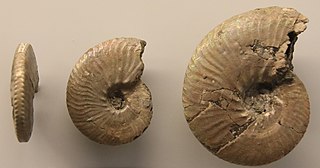Abbasites is an extinct genus of ammonites from the early Middle Jurassic epoch, included in the ammonitid family Erycitidae.

Anahoplites is a genus of rather involute, compressed hoplitid ammonites with flat sides, narrow flat or grooved venters, and flexious ribs or striae arising from weak umbilicle tubercles that end in fine dense ventrolateral nodes. The elements of their sutures are short, wide and jaggedy. Specimens of Annahoplites have diameters typically in the range of 4–6 centimetres (1.6–2.4 in) although some with diameters of as much as 19 centimetres (7.5 in) have been reported. The genus lived during the Cretaceous, from the Middle to the late Albian.

Puzosia (Bhimaites) is a subgenus of desmoceratid ammonites with a subinvolute, mostly smooth, high whorled shell with convex or flat sides and frequent constrictions on the venter. It is included in the subfamily Puzosiinae and has been found in Upper Albian and Cenomanian sediments in Angola, South Africa, and southern India.

Acanthoceratidae is an extinct family of acanthoceratoid cephalopods in the order Ammonitida, known from the Upper Cretaceous. The type genus is Acanthoceras.
Haploceratoidea, formerly Haplocerataceae, is an extinct superfamily of ammonoid cephalopods belonging to the Ammonitida that unites three families, Strigoceratidae, Oppeliidae, and Haploceratidae, listed below.
Neoptychites is an extinct ammonoid cephalopod genus from the Turonian stage of the Upper Cretaceous, with a worldwide distribution.

Collignoniceratidae is a family of Upper Cretaceous ammonites characterized by typically more or less evolute shells with compressed, oval, or square whorl sections; serrate or entire keels; and dense ribs with one to 5 tubercles.

Acanthoceratoidea, formerly Acanthocerataceae, is a superfamily of Upper Cretaceous ammonoid cephalopods belonging to the order Ammonitida, and comprising some 10 or so families.
The Haloritidae is a family of subglobular, involute, Triassic ammonoids belonging to the ceratitid superfamily Tropitoidea. Their shells may be smooth or may have ribs that cross or are interrupted on the venter, and may have nodes. Keels and ventral furrows are not typical. The last volution is commonly eccentric. The Suture may be ammonitic, ceratitic, or goniatitic.

Berriasellinae is a subfamily of very late Jurassic and very early Cretaceous perisphinctoid ammonites in the family Neocomitidae. Berriasellinae comprises generally compressed, evolute genera, typically with furcated ribbing, and in some a smooth ventral band or groove. Berriasellinae are derived from the Ataxioceratidae and gave rise to the other Neocomitidae. The short lived Himalayitidae from the uppermost Jurassic have a similar appearance but differ in being generally broader and having sharper ribbing.

Perisphinctoidea, formerly Perisphinctaceae, is a superfamily of Middle Jurassic (Bajocian) to Lower Cretaceous (Barremian) ammonites, commonly with evolute shells with strong ribbing that typically divides about mid flank before crossing the venter.
Protaconeceras is a deeply umbliciate, involute haploceratacean ammonite from the Lower Cretaceous included in the oppeliid subfamily Aconeceratinae. The shell of Protaconeceras has a crunulate keel, especially in the youth. Sides are slightly convex and are covered with flexious striae or flattened ribs that extend onto the ventral surface. Sutural elements are wider and shallower than in Aconeceras. The stratigraphic range is confined to the Hauterivian.

The Hoplitidae is a family of Cretaceous ammonites that lived during the middle of the period from the late Aptian to the Cenomanian. They are part of the superfamily Hoplitoidea.
Cravevoceras is an Upper Paleozoic ammonite in the goniatite family Cravenoceratidae, probably derived from Pachylyroceras and contemporary with other cravenoceratid genera like Caenolyroceras, Tympanoceras and later Alaoceras and Lyrogoniatites. It is also a member of the Neoglyphioceratoidea.

Perisphinctidae is a family of Middle and Upper Jurassic discoidal ammonites in the order Ammonitida. They have a shell morphology that is mostly evolute, typically with biplicate, simple, or triplicate ribbing. Large forms have simple apertures and smooth body chambers while small forms have lappets and ribbed body chambers.
Polymorphitidae is a family of Early Jurassic ammonoid cephalopods that contribute to the Eoderoceratoidea. Two subfamilies, the Polymorphtinae and Tropidoceratinae, are included.

The family Dactylioceratidae comprises Early Jurassic ammonite genera with ribbed and commonly tuberculate shells that resembled later Middle Jurassic stephanoceratids and Upper Jurassic perisphinctids. Shells may be either evolute or involute.

Watinoceras is a genus of acanthoceratid ammonite that lived during the early Turonian stage of the Late Cretaceous.
Euomphaloceratinae is a subfamily of Upper Cretaceous ammonites included in the Acanthoceratidae, characterized by generally evolute shells with quadrate whorl sections that are strongly ribbed. Sutures are ammonitic, but not overly complex.

Hammatoceratidae is a family of lower and middle Jurassic ammonites included in the superfamily Hildoceratoidea.











